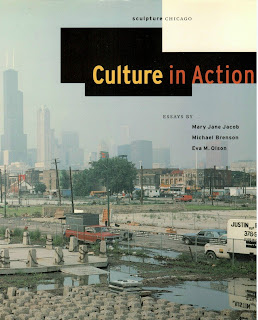„Cultura en Acción“, discutir, conversar, decidir, educar
Buscando establecer ese puente que aúne el arte y la vida ocho proyectos de arte público fueron desarrollados (que ya no tanto expuestos) durante los años 1992 y 1993 en la ciudad de Chicago comisariados por Mary Jane Jacob. Bajo el nombre de Cultura en Acción los artistas y los miembros de diversas comunidades de la ciudad de Chicago se unieron para indagar en torno a cuestiones sociales y políticas reales.
Consequences of a Gesture and 100 Victories/10,000 Tears by artist Daniel Martinez was a two-part project (1993) that tracked the history of the American immigrant labor movement by identifying important events in Chicago for which no monument or marker exists. Martinez wanted his work to recognize existing cultures in neighborhoods and encourage interaction among people in geographically and culturally isolated parts of the city. The project’s two parts were:
- Consequences of a Gesture, a parade that brought together Mexican American and African American groups who do not generally join forces.
- A public art monument called 100 Victories/10,000 Tears evolved out of one of the parade locations, the Maxwell Street Market area. It has a rich history as a settlement for various ethnicities and racial groups but was greatly reduced in 1957 when a portion of the community was demolished to build an expressway. The area had become a hotly contested location at the time of Martinez’s project because of the University of Illinois‘ efforts to expand its adjacent campus, thereby threatening once again to displace the poor people in the community. That issue, coupled with this community’s history as the site of the 1886 Haymarket Riot, where workers came into conflict with management and changed the course of labor history worldwide, became the thrust of 100 Victories/10,000 Tears. Martinez created a monument to labor using giant granite slabs from a building being torn down on the University of Illinois campus.
Civic Engagement/Dialogue Activities
100 Victories/10,000 Tears was recognized by contingents that stood at opposite ends of the debate on the future of the market and the university. Though removed mysteriously after five months, Martinez’s monument became a catalyst and forum for dialogue. Martinez saw value in being an outsider, perhaps able to see another’s situation more clearly than those inside.
In broad terms, Culture in Action was concerned with „spaces of discourse“ and the „active continuum of sculptural and cultural space.“ Dialogue occurred through communal action on the various projects. Recognizing that there are many publics, Culture in Action addressed itself first and foremost to constituents for whom the social issues were of primary concern. „The objects that resulted from the interactive process of Culture in Action were the locus for shared sentiments and means of communication with other audiences,“ said Mary Jane Jacob. „Their form, even if unconventional and more tied to conceptual genre than tradition, did not pose a barrier: Artists and audiences intersected at the point of meaning and joined in determining the form of expression their dialogues would take.“
Discussion and education were intrinsic to each artist’s project. Each project had many parts and a number of these served educational functions for different audiences. For example, the installation, Flood, by the artist group Haha, actively involved health volunteers in cultivating a hydroponic garden to produce vegetables and therapeutic herbs for use by HIV/AIDS service organizations. The garden served as a space for community dialogue as well as a metaphor for caregiving. The installation was toured daily by groups and discussions were held on site and were open to others who dropped in. The artists and their collaborators also held sessions among themselves with invited speakers.
(See also Televecindario, another Culture in Action project, in Media Arts.)
Information Sources
Jacob, Mary Jane, Michael Brenson, Eva M. Olson. Culture in Action. Seattle: Bay Press, 1995
